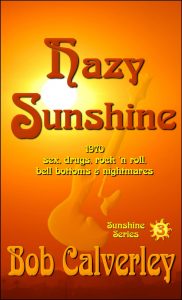Review by Mack Hassler
“…the Lord came down to see the City and the tower the people
were building…. [he said] Come, let us go down and confuse
their language so they will not understand each other.”
Genesis 11: 5-7
Reading Genesis, by Marilynne Robinson (2024)
 The author of this trilogy was born in Ontario, grew up near the Sault Locks in the high Upper Peninsula of Michigan and graduated high school there in 1963. A graduate of Michigan State University in journalism, Calverley was an award-winning newspaper reporter later at the Detroit Free Press. He was drafted by the U.S. Army in 1967 and served a year in Vietnam with the 187th Assault Helicopter Company. He now serves on the Board of Directors of the 187th Assault Helicopter Company Association and lives in Southern California, is a writer, and teaches some communications for an engineering unit at USC. He still belongs to the UPPAA, however; and this huge fictional trilogy reads as more or less an autobiographical fiction ranging across the saga of life in the late sixties from Vietnam to Detroit with mentions of East Lansing and the UP. The author tells me in an email that the narrative is NOT an autobiography because he is not a skilled guitarist, as his two main characters are, and he did not share in the drug culture during the several years of the narrative. So the stories are fiction. Therefore in reading the stories and in having lived very anxiously through this same period in our history (also with no musical skills and with no drugs except for the smell of pot when students would come to my house for parties) I think I can read the overall literary effects that stem from the character traits and from the cultural trends due to the war and due to race as origin type stories ranging from the hopefulness even in the trauma of 1968 to the haze of eviction out of Eden in 1970 as echos of Genesis stories. Even with my tentativeness, Calverley may decide to blast me for this reading.
The author of this trilogy was born in Ontario, grew up near the Sault Locks in the high Upper Peninsula of Michigan and graduated high school there in 1963. A graduate of Michigan State University in journalism, Calverley was an award-winning newspaper reporter later at the Detroit Free Press. He was drafted by the U.S. Army in 1967 and served a year in Vietnam with the 187th Assault Helicopter Company. He now serves on the Board of Directors of the 187th Assault Helicopter Company Association and lives in Southern California, is a writer, and teaches some communications for an engineering unit at USC. He still belongs to the UPPAA, however; and this huge fictional trilogy reads as more or less an autobiographical fiction ranging across the saga of life in the late sixties from Vietnam to Detroit with mentions of East Lansing and the UP. The author tells me in an email that the narrative is NOT an autobiography because he is not a skilled guitarist, as his two main characters are, and he did not share in the drug culture during the several years of the narrative. So the stories are fiction. Therefore in reading the stories and in having lived very anxiously through this same period in our history (also with no musical skills and with no drugs except for the smell of pot when students would come to my house for parties) I think I can read the overall literary effects that stem from the character traits and from the cultural trends due to the war and due to race as origin type stories ranging from the hopefulness even in the trauma of 1968 to the haze of eviction out of Eden in 1970 as echos of Genesis stories. Even with my tentativeness, Calverley may decide to blast me for this reading.
This first fiction by Calverley centers around the adventures of Jimmy Hayes and his fictional girlfriend and musical partner, the very Nordic-looking Gloria, who is known as “Sunshine” because of her fair complexion, long yellow hair, and innocence. She is from a broken and violent family in the Detroit area, and is essentially homeless when she meets Jimmy making music with their guitars and doing drugs in East Lansing and Detroit in 1967. Both are excellent and energetic in their mastery of the instrument, and they hook up with some Black friends who are enterprising enough to publish some of their lyrics and guitar work in albums. Because of drugs and uncertainty the culture is very violent; and one of their friends and promoters, a Black named Roscoe, is murdered. With many hints throughout but explicitly by the third volume, it is clear that the natural father of Sunshine is a light-skinned Black in the entourage of the fictional Senator Logan Carlton, whom Calverley says on his blog is inspired by Detroit’s crusading Black mayor Coleman Young.
 Though Calverley produces a clearly developed and nearly epoch-making narrative in his depiction of the surprises and violent and colorful Culture of Woodstock, the anti-war movement, the musically inventive and the racially-charged society of the time, I think the story-telling exudes the Old Testament sense of chosenness and origins. My shorter epigraph above to this review is to the award-winning novelist Marilynne Robinson, who also bases her thoughts on a close reading of scripture. Her new non-fiction book argues that all the Genesis stories were written by the Hebrews themselves—the epic explanations of the human story. Here is a short portion from the start here of volume 2 by Calverley to explain some of Jimmy’s background (Hitler liked to carry a sidearm and liked killing), “How’d you know… about them, Nazis?’ Learned it in school,’ Hayes lied. He’d learned most of it from his Uncle Sepp, a Finn who’d fought for the Wehrmacht in World War II, something Hayes didn’t like to talk about.” (volume 2, p. 36). For those of us close to the age of Jimmy and Sunshine the tale has a fascinating and welcoming feel of identity. Most strange, in fact, is this character of Jimmy, whom they call “the Finn” in the first volume when he and Gloria are falling in love. Both are fascinated with the language of the guitar and both are good enough to learn modes of expression and to experiment in their playing much like the Beatles. Also, they play their bodies just like their instruments in their lovemaking It is no surprise that Gloria at the age of 15 is pregnant. But in addition, it is so strange that Jimmy finds that he likes to kill. He is a gunner soon on one of the helicopters, and the bursts of fire that he can send from his powerful weapon gives him an elevated sense of being alive— like the Shepherd and Musician David leading the Hebrews into battle.
Though Calverley produces a clearly developed and nearly epoch-making narrative in his depiction of the surprises and violent and colorful Culture of Woodstock, the anti-war movement, the musically inventive and the racially-charged society of the time, I think the story-telling exudes the Old Testament sense of chosenness and origins. My shorter epigraph above to this review is to the award-winning novelist Marilynne Robinson, who also bases her thoughts on a close reading of scripture. Her new non-fiction book argues that all the Genesis stories were written by the Hebrews themselves—the epic explanations of the human story. Here is a short portion from the start here of volume 2 by Calverley to explain some of Jimmy’s background (Hitler liked to carry a sidearm and liked killing), “How’d you know… about them, Nazis?’ Learned it in school,’ Hayes lied. He’d learned most of it from his Uncle Sepp, a Finn who’d fought for the Wehrmacht in World War II, something Hayes didn’t like to talk about.” (volume 2, p. 36). For those of us close to the age of Jimmy and Sunshine the tale has a fascinating and welcoming feel of identity. Most strange, in fact, is this character of Jimmy, whom they call “the Finn” in the first volume when he and Gloria are falling in love. Both are fascinated with the language of the guitar and both are good enough to learn modes of expression and to experiment in their playing much like the Beatles. Also, they play their bodies just like their instruments in their lovemaking It is no surprise that Gloria at the age of 15 is pregnant. But in addition, it is so strange that Jimmy finds that he likes to kill. He is a gunner soon on one of the helicopters, and the bursts of fire that he can send from his powerful weapon gives him an elevated sense of being alive— like the Shepherd and Musician David leading the Hebrews into battle.
So I think that, plus the powerful music plus the sense of freedom from race, and eventually the crusading racial justice brought into the narrative clearly in the final volume, Calverley builds for his reader a particular “Michigan,” and sadly for a UP literature, a particular lower peninsula version of the “Genesis stories” we have seen again and again in English literature: Milton’s Paradise Lost; Melville’s Moby Dick, the Ahab story.. By the third volume in Calverley, the great Edenic promise of new creation—new musical modes and languages, new sexual language and excitement of love, even the redemptive value of killing (remember that Jesus says once the Old Testament has run its course that he must be killed for all of us to live) have each faded to “haze” and like our first parents in Milton’s great epic poem Jimmy and Sunshine are more or less cast out of the garden and, as Milton puts it, “…through Eden make their solitary way.” Love is fading between Jimmy and Gloria. His ” Nam nightmares” are unnerving her. Even her own clear links to the impossible task of the great American issue of racial justice pale with the ambivalence over Blackness. All three volumes are well-made and sturdy books with colorful and striking cover illustrations and colors. Much more than autobiography, the narrative is a solemn, fully-developed set of stories that echo a lot from Genesis. Calverley is very hopeful in his epic work I am glad he did it.
Purple Sunshine: sex & drugs, rock & roll, war, peace &Love (volume 1), by Bob Calverley (2013) 523 pages, pbk, $16.95;
Sunshine Blues: 1968 sex, drugs &rock ‘n roll but the peace & love are dying (volume 2), by Bob Calverley (2021) 521 pages, pbk, $16.95;
Hazy Sunshine: 1970 sex, drugs, rock ‘n roll, bell bottoms & nightmares (volume 3), by Bob Calverley (2024) 418 pages, pbk, $16.95. [Each volume is “a Bob Calverley Publication”]



